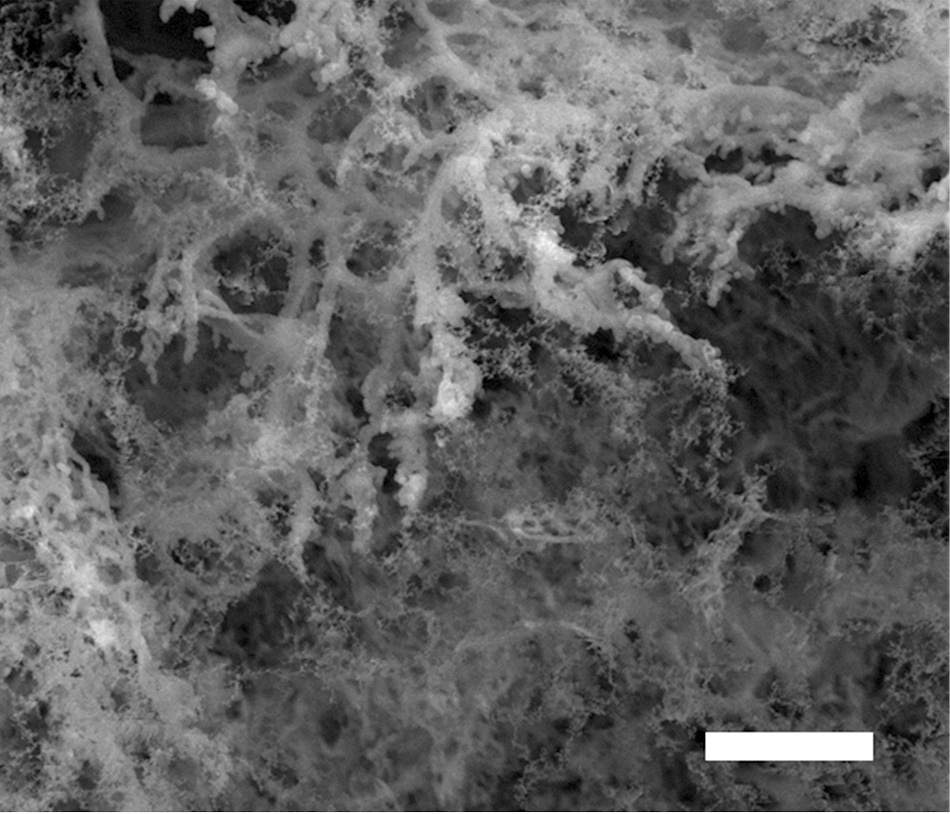May 16 2017
 Laser-induced graphene created in the presence of argon gas is superhydrophobic, meaning it avoids water. The process developed at Rice University makes materials that can be superhydrophilic or superhydrophobic from inexpensive materials and in one step. (Credit: Tour Group/Rice University)
Laser-induced graphene created in the presence of argon gas is superhydrophobic, meaning it avoids water. The process developed at Rice University makes materials that can be superhydrophilic or superhydrophobic from inexpensive materials and in one step. (Credit: Tour Group/Rice University)
Researchers from Rice University who are credited for inventing laser-induced graphene (LIG) for applications such as supercapacitors have recently discovered a way to create the spongy graphene either superhydrophilic or superhydrophobic.
And it is a gas.
So far, the Rice lab of James Tour created LIG only in open air, using a laser to burn portion of the way through a flexible polyimide sheet to obtain interconnected flakes of graphene. But placing the polymer in a closed environment with a variety of gases altered the product’s properties.
Creating LIG in hydrogen or argon makes it superhydrophobic, or water-avoiding, a property greatly valued for de-icing surfaces or separating water from oil. Creating it in oxygen or air turns it superhydrophilic, or water-attracting, and that makes it very soluble.
Water rolls off a superhydrophilic laser-induced graphene pattern placed inside a superhydrophobic LIG frame. (Credit: Tour Group/Rice University)
The study conducted at Rice and at Ben-Gurion University in Israel is the subject of a paper in Advanced Materials.
“Labs could make graphene either hydrophobic or hydrophilic before, but it involved multiple steps of either wet-chemical or chemical vapor deposition processes. We’re doing this in one step with relatively cheap materials in a homemade atmosphere chamber.
James Tour, Rice University
The labs got an additional benefit when they discovered that making LIG in oxygen raised the number of defects – 5- and 7-atom rings – in the graphene flakes, enhancing its capacitance and its performance when used as an electrode material for microsupercapacitors.
Changes in the chemical content of the gas and even alterations in the direction of the laser raster pattern changed the material, causing the research team to believe LIG’s hydrophobic or –philic properties could be tweaked.
They also found out that when they scraped graphene off of a hydrophilic sheet of polymer and converted it into a film, the result was hydrophobic instead.
That leads us to believe the surface orientation of LIG’s flakes have a lot to do with how it reacts with water. If the edges are more exposed, it appears to be hydrophilic; if the basal planes are more exposed, their hydrophobic properties take over.
James Tour, Rice University
What renders a material “super” in either direction is the angle at which it meets water. A material with a contact angle of 0° is said to be superhydrophilic. In this case, water would form a puddle on the material. If the angle is 150° or greater, that is superhydrophobic; the angle is established by how much the water beads. (An angle of 180° would be a sphere sitting flawlessly on top of LIG.)
The discovery that chemistry and surface type affect LIG should also allow some scope in altering the material’s properties, Tour said. In fact, when they used a sulfur/fluorine gas to form it, they increased LIG’s superhydrophobicity to 160°.
Yilun Li, a graduate student at Rice, is the paper’s lead author. Co-authors are Rice graduate students Duy Xuan Luong and Jibo Zhang, undergraduate Yash Tarkunde, research scientist Carter Kittrell and former postdoctoral researcher Yongsung Ji; and graduate student Franklin Sargunaraj and co-principal investigator Christopher Arnusch, a lecturer at the Zuckerberg Institute for Water Research at Ben Gurion University of the Negev, Israel. Tour is the T.T. and W.F. Chao Chair in Chemistry as well as a professor of computer science and of materials science and nanoengineering at Rice.
The research was supported by the Air Force Office of Scientific Research and its Multidisciplinary University Research Initiative and the Vietnam Education Foundation.